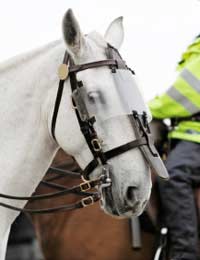Train Horses for Work Situations

Training Horses for Work Situations
Historically, horses worked on farms and served in battles - as well as being ridden. Withthe introduction of agricultural machinery, fewer plough horses were needed and the war horse is confined to the history books. Today, there are other work situations for these versatile creatures.Horses for Courses
Before a horse can be considered for any type of training for work, there are several things to consider:- What is expected of the horse?
- Is it the right shape, size, colour and age?
- Does the horse have a suitable temperament for the work?
These points may seem obvious, but it would not make sense to select a horse fortraining, for example, as a Drum Horse, if it couldn’t carry the weight of the drums! The people who select horses for specific work know what to look for and can spot horses that have potential for the job in question. Some horses are bred for the work to ensure certain traits are kept.
Example - The Drum Horse
These huge coloured horses are used most in British Pageantry. They have to be a big breed, usually Shires, to carry the weight of 2 enormous silver drums, the drummer and all related paraphernalia. They also have to be exceptionally well mannered and even tempered,because they are expected to stand still for hours, with drums banging in their ears and the drummer’s arms moving quickly up and down behind them. With all this going on, all the drummer has to control the horse with is his feet, so he must be able to trust the horse to stand still! A horse that could not cope with loud noises wouldn’t last long in this training.Fight or Flight Instinct
Horses have a built-in survival instinct called fight or flight. To escape danger in thewild, a horse would gallop away. This instinct has to be adapted, through training, for the work involved (otherwise out-of-control, frightened horses would be bolting in all directions, causing danger to themselves and everyone near them). Horses are taught to remain calm, accept the halter and stand still from a very early age, through human contact.For example, the inexperienced police horse, aged between 4 and 7 years, will go through a gradual desensitisation process during its training. This is to build confidence and promote trust between horse and rider, by being exposed to flapping flags, noisy crowds, being touched by different materials, and other external stimuli. Training takes several months and is never rushed. Good trainers appreciate that each horse is an individual.


Re: Run your own Animal Shelter
Hello guys, just came across this site and it warms my heart that there aren't many people willing to help these little guys.…
Re: Work With Horses: Becoming a Stablehand
Hey my names Ava and I just turned 14 a few days ago, I have lots of experience with both riding and handling horses…
Re: Run your own Animal Shelter
Hello I am live in birmingham and I really like to open rescue centre for animals . Please help me with the step by step
Re: Run your own Animal Shelter
Just read this. I was considering buying land with stables into a cat sanctuary and I didn't realise you have to approach a council…
Re: Run your own Animal Shelter
Hi all, I currently manage a children's home and love it but I have always wanted to care for animals. Can anyone help me to learn…
Re: Work with Farm Animals or on a Farm
Hi I'm from Bulgaria.I was looking a job for farms with animals.I have 1.5 years experience at pigs farm and 3 years for…
Re: Work as a Flying Groom
Hi there this is a useful article, however how do you actually go about finding employment in this role? Please advise. Best wishes Jon
Re: General Work Experience with Animals
I am currently in year 10 and I was looking into your placements as I will need one week of experience in July. I am…
Re: Run your own Animal Shelter
Hi I see there are like minded individuals who feel and know the need to help animals more so now than ever! It would be amazing if…
Re: Run your own Animal Shelter
I look after fieldmice that already inhabit an old church, the 'church mice' if you like. As the mice destroy woodwork, masonry,…